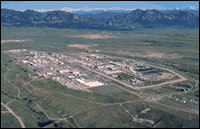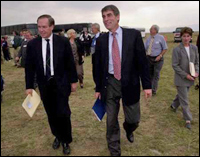The plotline sounds as absurd as a made-for-TV movie: An FBI agent exposes deadly contamination at an old nuclear-weapons plant, but the federal government conceals the findings. Years later, Congress votes to convert the tract into a wildlife refuge and open it to school field trips and public recreation. The site becomes a poster child for eco-friendly nuclear-waste disposal — with a dangerous radioactive secret lurking below the surface.

An aerial view of Rocky Flats.
Photo: Los Alamos National Laboratory.
Fact, of course, can be stranger than fiction — even bad Sunday-night-on-CBS fiction — and former FBI agent Jon Lipsky is one of several insiders who say the above scenario is unfolding right beneath Uncle Sam’s nose.
In 1989, Lipsky led an FBI raid on the Rocky Flats nuclear-weapons plant in Colorado after receiving reports that the plant posed a huge public-health threat. His raid, which took place over 18 days and involved more than 100 FBI and EPA officials, gave way to a nearly three-year criminal investigation into widespread radioactive contamination of the air, water, and soil at the 6,240-acre site and the surrounding suburbs of nearby Denver.
The raid prompted the Department of Justice to assemble a special grand jury to investigate the evidence against U.S government officials and Rockwell International, the private defense contractor that managed Rocky Flats from 1975 to 1989 on behalf of the Department of Energy. Rockwell pleaded guilty to certain counts of negligence and paid a fine, but never fessed up to the full extent of the crimes Lipsky says he witnessed. The case was settled with a plea bargain agreement, and the Department of Justice sealed the contamination evidence from the public.
Next month, Lipsky will be party to a lawsuit against DOJ in conjunction with Wes McKinley, the former leader of the Rocky Flats grand jury, and Jacque Brever, a former chemical operator at the plant who suffers from radiation exposure, in an effort to unseal the documents.
The plaintiffs are concerned, in particular, about a 2001 congressional decision to turn Rocky Flats into a wildlife refuge, which may have as many as 16 miles of trails for hiking and horseback riding. On Dec. 31, Lipsky retired early from the FBI to protest the agency’s orders that he keep mum about the Rocky Flats controversy. “I left so I could help expose the truth,” he told Muckraker. “Without the truth there can be no real understanding of the extent of this environmental crime, and there can be no thorough cleanup.”
Lipsky describes the DOE’s ongoing cleanup effort at the nuke site, scheduled to be completed by 2006, as “woefully inadequate — a farce.” As for the decision to make Rocky Flats a tourist destination, he said, “There is nothing safe or sane about it.”
Before the vote on the Rocky Flats designation, Lipsky wrote an open letter to Congress putting his objections in no uncertain terms: “I am an FBI agent. My superiors have ordered me to lie about a criminal investigation I headed in 1989. The Justice Department covered up the truth … I have refused to follow the orders … Some dangerous decisions are now being made based on that government cover-up.”
He exhorted members of Congress to read the book The Ambushed Grand Jury, a chronicle of the cover-up by Colorado lawyer Caron Balkany, who is representing Lipsky et al. in their lawsuit, and McKinley, the former grand-jury member, who was just elected to the Colorado state legislature.
The DOE dismisses Lipsky’s charges as bunk. Department spokesperson Karen Lutz flatly denies that there’s anything to be concerned about. “Our Rocky Flats cleanup effort has been going on for 15 years, and the whole time it has been meticulous, thorough, and transparent, with full community participation. We’ve had this under a microscope — the oversight has been incredibly vigilant. There is nothing legitimate about these allegations.” The Department of Justice did not respond to Muckraker’s request for comment.

What lurks beneath the tallgrass?
Photo: RFETS.
The critics counter that DOE wanted to keep the public in the dark to cut corners on cost, not to mention protect itself from criticism for environmental negligence. The department allocated $7 billion to the cleanup, a sum initially criticized as far too low to enable a thorough job. And less than 8 percent of the allocated sum is even being used to decontaminate the site, the plaintiffs say; the rest is going to administrative costs and decommissioning the plant.
Former Rocky Flats employee Jacque Brever, who claims to have read more than 16,000 documents on the cleanup, told Muckraker that the effort is “so bad you wouldn’t even believe it.” She said several fields and hillsides that had been dumping grounds for toxic and radioactive wastes have been excluded from the cleanup. Additionally, she said, the sampling techniques for determining contamination levels are misleading, and the standards for soil and water purification are weak.
“There is no question in my mind that the grounds are still hot [radioactive] at that site, and will be for a long time,” she said. “That plant was spewing radioactive ash and effluent for nearly 40 years. We dumped radioactive stuff in areas they’re not even looking at. We buried drums that corroded underground, and they’re looking only at the surface of the soil.” Brever worked at the plant for 10 years and her fiancé for 19 years. Both spent most of their careers in “hot” areas of the facility where they were directly exposed to plutonium. Brever now has thyroid cancer and her fiancé has a rare form of eye cancer, both illnesses associated with long-term exposure to radioactivity. They haven’t been able to get financial compensation for their medical treatment, she said, because some key records pertaining to their exposure have been suppressed. “We’re having difficulty proving our case. That’s why we’re taking it to the courts — to get the rest of our records released.”

Allard (left) and Udall introduce the Rocky Flats National Wildlife Refuge Act.
The effort to transform Rocky Flats into a wildlife refuge was lead by Colorado Rep. Mark Udall (D) and Colorado Sen. Wayne Allard (R). But at the time, says Lipsky, Udall and Allard, like everyone else, didn’t have access to all the facts. “Congress didn’t know that there was midnight plutonium burning. Congress didn’t know that there was extensive offsite contamination. Congress didn’t know the site had an irrigation system that dispersed radioactive liquid from the holding ponds throughout the surrounding fields to skirt discharge constraints.”
McKinley has announced that he will introduce a bill in the Colorado legislature that would require officials at the Rocky Flats National Wildlife Refuge to warn visitors of the site’s past. “People shouldn’t visit a so-called park that for half a century has been a radioactive waste dump without knowing about the malfeasance that happened there,” he said. “You get warning labels on hot coffee, why shouldn’t you be warned that you could be walking on ‘hot’ ground?”
What concerns attorney Balkany the most is that the Rocky Flats cleanup could be used to fuel the myth that nuclear waste can be safely handled. “I believe the main goal of the DOJ and the nuke industry at Rocky Flats is greenwashing. It helps both nuclear power and the nuclear-weapons industries to convince people that industries and government can deal with their waste in a safe way,” she said.
This could be of particular interest to the Bush administration, given that just last week, in President Bush‘s first newspaper interview since his reelection, he told The Wall Street Journal of his hopes to spark a nuclear-power renaissance, glorifying nuclear power in ways that many would deem delusional: “I believe nuclear power answers a lot of our issues,” he said. “It certainly answers the environmental issue.” He later added: “It’s a renewable source of energy.” Who’s ever heard of renewable energy that creates cancer-causing waste?
“Just watch,” said Brever. “They’re going to hold up Rocky Flats as the nuclear-waste success story, the flagship. It’s going to happen all over the country: Washington is going to make nuclear-waste dumps into plutonium playgrounds.”

